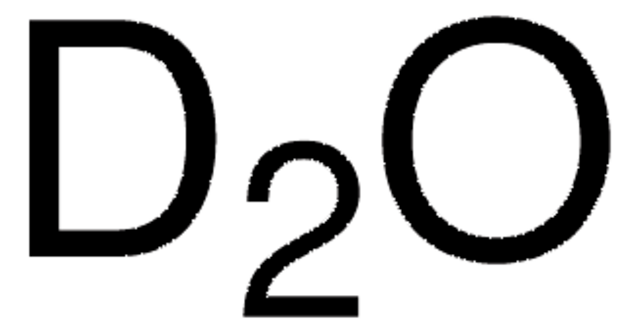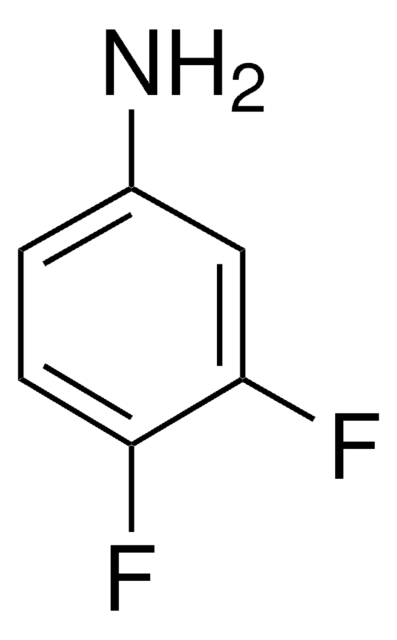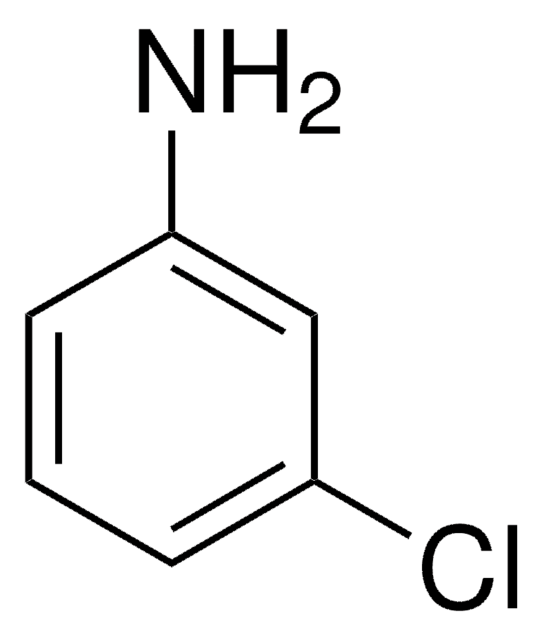437778
3,4-Dichloroaniline
98%
동의어(들):
3,4-Dichlorobenzenamine, 3,4-Dichlorophenylamine, 4,5-Dichloroaniline, 4-Amino-1,2-dichlorobenzene, m,p-Dichloroaniline
로그인조직 및 계약 가격 보기
모든 사진(3)
About This Item
Linear Formula:
Cl2C6H3NH2
CAS Number:
Molecular Weight:
162.02
Beilstein:
636837
EC Number:
MDL number:
UNSPSC 코드:
12352100
PubChem Substance ID:
NACRES:
NA.22
추천 제품
Quality Level
분석
98%
bp
272 °C (lit.)
mp
69-71 °C (lit.)
작용기
chloro
SMILES string
Nc1ccc(Cl)c(Cl)c1
InChI
1S/C6H5Cl2N/c7-5-2-1-4(9)3-6(5)8/h1-3H,9H2
InChI key
SDYWXFYBZPNOFX-UHFFFAOYSA-N
유사한 제품을 찾으십니까? 방문 제품 비교 안내
일반 설명
3,4-Dichloroaniline (3,4-DCA) is an aromatic amine and is a model environmental contaminant. It is an important precursor for the synthesis and degradation product of several herbicides. It is a metabolite of commonly applied herbicide, 3,4-dichloropropionanilide or propanil. Biodegradation kinetics of 3,4-DCA has been reported. Mechanism of degradation of aqueous 3,4-DCA in a novel dielectric barrier discharge plasma reactor has been studied. 1,2-dichlorobenzene, 2-chloro-1,4-benzoquinone, 3,4-dichlorophenyl isocyanate, 2-chlorohydroquinone, 3,4-dichloronitrobenzene and 3,4-dichlorophenol were identified as degradation intermediates by GC-MS analysis.
애플리케이션
3,4-Dichloroaniline may be employed as derivatization reagent for the HPLC analysis of perfluorooctanoic acid (PFOA).
신호어
Danger
유해 및 위험 성명서
Hazard Classifications
Acute Tox. 3 Dermal - Acute Tox. 3 Inhalation - Acute Tox. 3 Oral - Aquatic Acute 1 - Aquatic Chronic 1 - Eye Dam. 1 - Skin Sens. 1
Storage Class Code
6.1A - Combustible acute toxic Cat. 1 and 2 / very toxic hazardous materials
WGK
WGK 3
Flash Point (°F)
275.0 °F - closed cup
Flash Point (°C)
135.00 °C - closed cup
개인 보호 장비
Eyeshields, Faceshields, Gloves, type P2 (EN 143) respirator cartridges
이미 열람한 고객
M Monteiro et al.
Chemosphere, 62(8), 1333-1339 (2005-09-20)
The aromatic amine 3,4-dichloroaniline (DCA) is a model environmental contaminant, precursor for synthesis and degradation product of several herbicides, which is commonly found in European estuarine ecosystems. In this work, the possibility of using biochemical and histological markers to assess
Nan Ye et al.
Nanotoxicology, 12(5), 423-438 (2018-04-17)
Concomitant releases of various engineered nanoparticles (NPs) into the environment have resulted in concerns regarding their combined toxicity to aquatic organisms. It is however, still elusive to distinguish the contribution to toxicity of components in NP mixtures. In the present
Ricardo Marques et al.
Environmental science and pollution research international, 22(9), 6687-6695 (2014-11-26)
This study models the biodegradation kinetics of two toxic xenobiotic compounds in enriched mixed cultures: a commonly applied herbicide (3,4-dichloropropionanilide or propanil) and its metabolite (3,4-dichloroaniline or DCA). The dependence of the metabolite degradation kinetics on the presence of the
Guoqiang Shan et al.
Se pu = Chinese journal of chromatography, 32(9), 942-947 (2015-03-11)
A simple derivatization method followed by high performance liquid chromatography (HPLC) for the analysis of perfluorooctanoic acid (PFOA) was developed. PFOA was firstly derivatized with 3,4-dichloroaniline (DCA) using carbodiimide method. The typical amidate product was characterized by mass spectrometry (MS).
Jingwei Feng et al.
Environmental science and pollution research international, 22(6), 4447-4459 (2014-10-16)
Degradation of aqueous 3,4-dichloroaniline (3,4-DCA) was conducted in a novel dielectric barrier discharge (DBD) plasma reactor. The factors affecting the degradation efficiency of 3,4-DCA and the degradation mechanism of 3,4-DCA were investigated. The experimental results indicated that the degradation efficiency
자사의 과학자팀은 생명 과학, 재료 과학, 화학 합성, 크로마토그래피, 분석 및 기타 많은 영역을 포함한 모든 과학 분야에 경험이 있습니다..
고객지원팀으로 연락바랍니다.
















